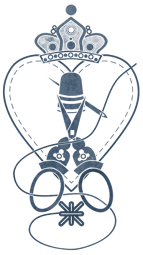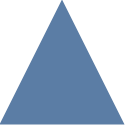
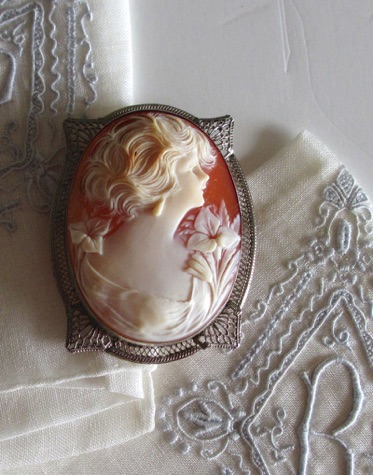
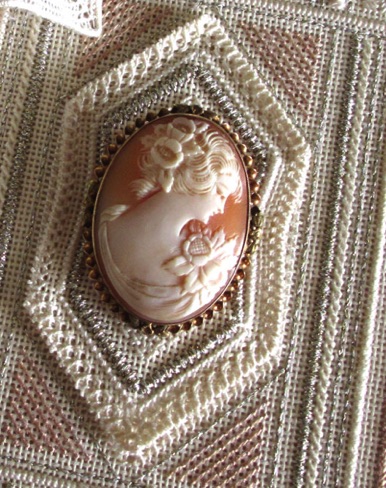
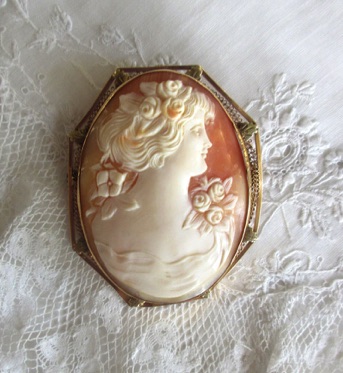
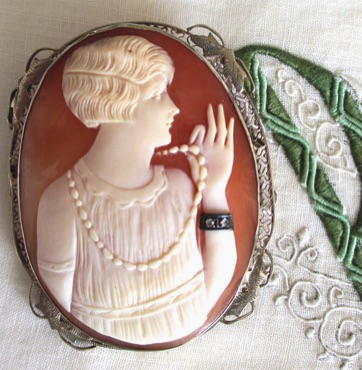
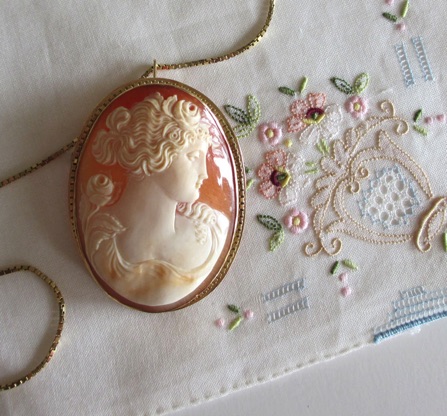
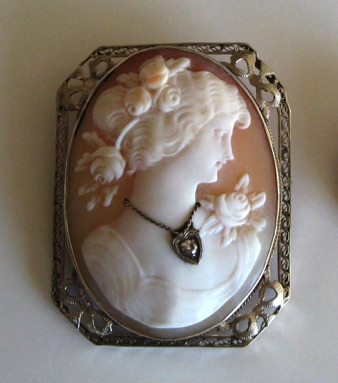
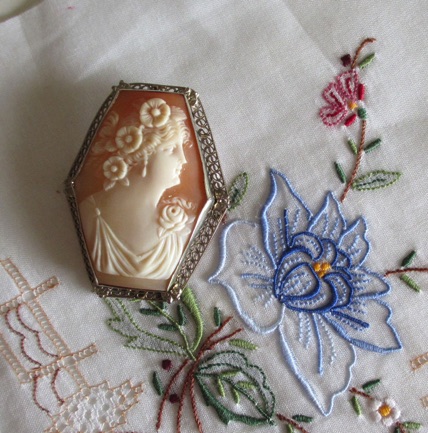
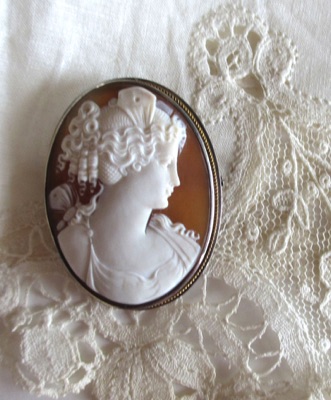
1950's
Look what happened to this nose: small, low bridge and pert, turned up.
1950's
Pre WW II
Between the Wars
(I know this to be 1930's)
Pre WW1
Pre WW1
Edwardian
This is Psyche (butterfly wing in her hair.)
Evolution of these FACES
Lessons #4 and #5 Scroll down.
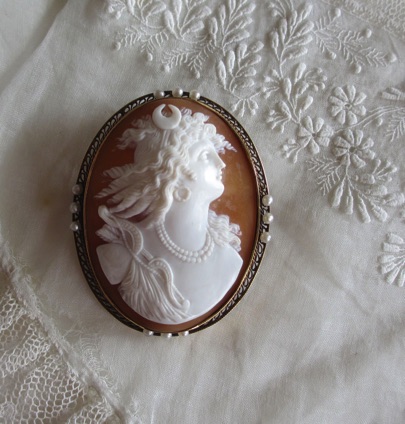
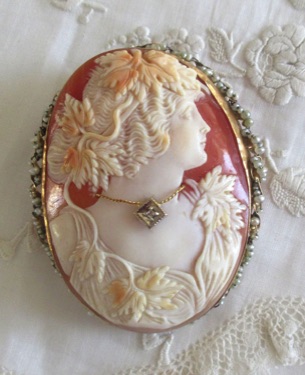
Victorian. This is Diana, the Goddess of the Hunt. You can identify her by thr cresent moon
Victorian.
If you wish to post your favorite cameo and your reasons why, will you join my Gay Ann Rogers Stitchalong Group on Facebook
Gay Ann Rogers Stitchalong Room on Facebook
https://www.facebook.com/groups/2467362096811360
From this page send me a request to join.
On NOSES, March 28, 2022
If you look at the faces of cameos arranged in chronological order, you will see that the style of a cameo's face evolves in time, noticeable in eyes and mouth, chinline and neck, but most noticeable in a cameo's nose.
Notice that the earlier the cameo, the higher the bridge of the nose and the straighter and larger the nose. In the most pronounced of this style, from the top of the forehead to the tip of the nose, the line is almost straight.
Most markedly you can see the difference in noses between cameos #2 and #9 (larger and straight) and cameo #8 (smaller and upturned).
Goddesses continued into the 20th century, but if you look carefully at #4, you will see that the image begins to soften.
Ideas of beauty evolve with time, hence the profiles of cameos #2 and #9 are the least favored among my followers, just as I notice that no one has written to me commending the great beauty of Sarah Bernhardt.
FACES Assignment #4, March 26, 2022
4-A Try to look just at the face of your cameo: how much detail do you see? If you were to draw the details of eyes nose and mouth, what would your drawing look like?
4-B With eyes and mouth little more than a suggestion and the nose basically a line, what makes one cameo prettier than another?
4-C How important is the chinline?
4-D What role does hair play?
4-E What role do additions such as flowers play?
4-F Any other considerations?
To help answer these questions, compare your favorite cameo with your least favorite cameo. As you look at both cameos, what are the differences?
FACES Assignment #4, My Notes March 29, 2022
I've given you some time to make notes on the questions in FACES Assignment #4, now I would like to add some comments over the next couple of days.
MY OBSERVATIONS
I like to troll on the web for visual ideas. I have lists of favorite topics to google and I collect screen shots of images that interest me and file them by topic on my computer. Not too long from now I will encourage you to do this and teach those of you on Apple computers quick ways to enjoy your collections.
One time when I was trolling for needlepoint faces I came across a cringeworthy example of a Needlepoint FACE if ever there was one. The nose on the face was pronouced enough on the painted canvas but the pronounced painting on the canvas wasn't enough for the stitcher. She doubled its effect by outlining it in black and padding it significantly so that it stood up off the canvas and all I saw was a honking big nose.
I wish I could post the piece but it wouldn't be kind to the stitcher and besides, I don't have permission to post it. In fact I don't have access to much to post: most everything is copyrighted these days.
So I turned to CAMEOS. I know they aren't needlepoint but they share in common one aspect with needlepointed faces: if you look carefully at the cameo faces you will see that the features are but simple outlines, mere suggestions of the features and mostly a simple clean line of a face.
LOOKING AT A PRETTY FACE
So what makes one cameo pretty and another not? I think the secret lies in the placement of the features, the proportions of the features and their positions in relation to one another. For example, the problem of the honking nose I mention above is that it totally dominated the other features. It didn't make for a harmonious presentation.
Many people who have followed this series don't like CAMEO #2, my oldest cameo. If you are someone who has a favorite cameo in the group and you con't like CAMEO #2, compare her to your favorite.
I'm guessing you don't like her pronouced nose, too straight, too large, and the high bridge. The placement of her eye in relation to the bridge of her nose seems a bit awkward to our eyes today. Her chin is round and fleshy and she looks almost like, with the swipe of a carver's knife, she could have a double chin. And what about that thick neck? Today's beauty wouldn't have that thick neck.
And her hair? Definitely belongs to a different age.
Now spend some time again looking through the cameos and see how beauty changes. Look what happens to the features: look how they change in size, proportion and placement. The Victorian sensibilities give way to sweeter, more pert and softer presentations, almost ot the point that Cameo #8 is the opposite of Cameo #2.
Size, proportion and location of features on a face can change the emphasis soo much! I hope you will take a few minutes not to stucy these relationships on all Ten Cameos.
Enough for today. I will continue tomorrow, with how some knowledge of proportion and placement of simple features might help you make better decisions about needlepoint faces.
FACES Assignment #5, March 30, 2022
Scroll down and read my notes from March 29, then read these.
I hope you have a screen shot of your favorite of my cameos. If so, have a good look at her.
Chances are, as I mentioned yesterday, her features are little more than a carved line or two to suggest an eye, and another for the mouth. Often these features, isolated on their own (away from the profile) are the same or similar to many other well-carved cameos.
What distinquishes one cameo from another has to do with the sizes of the features and where they are on the cameo's face. If the eye is too high or too low in relationship to the nose, even slightly, the expression on the cameo's face will change. Ditto the mouth in relationship to the eye, the nose and certainly the chin.
If the mouth is high, leaving a lot of chin, it looks odd, if too low it looks odd.
Here's an exercise for those of you who are interested in pursuing this: enlarge your favorite cameo's face and print it.
Place a sheet of tracing paper on top of the cameo and trace her face the best you can. On a second sheet of tracing paper trace the face and lengthen it, then readjust the features a bit and look what happens. On a third sheet of paper, try again, changing the proportions, on a fourth sheet another try.
Here's another version of the exercise: trace just the outline of the face onto tracing paper. On a separate sheet of tracing paper, trace the eye and the mouth, cut them out (leaving a small oval around each, place them on top of the face outline, move them around and watch what happens.
We as people are so sensitive to faces that even slight changes make a difference.
Notice something else? Notice how you can adjust the simple features in infinite positions?
Remember, this isn't true with a needlepoint face. Remember, in needlepoint you are confined to the grid, and the smaller the face, the fewer choices you have.
Adding to FACES Assignment #5, March 31, 2022
If you are catching up, scroll down and read the March 30 entry for FACES Assignment #5 before you read this.
Yesterday I described small exercises with tracing paper and a pencil. Say you buy a painted canvas and you aren't happy with the face. You can try the same exercise and adjust the face on the painted canvas. Here are some simple guidelines for adjusting a face:
1. Watch the relationship the features and adjust if necessary the distance between the eyes and the mouth, also the distance between the mouth and the chin.
2. Watch the nose: not too much detail or it is all you will see.
3. Eliminate all unnecessary details. No heavy dark eyebrows, no hot pink cheeks, very little shading on a small face. Take a suggestion from cameos: how many of them have eyebrows at all?
4. Here is a general guideline: the smaller the face in needlepoint, the fewer the details. The larger the face, the more details you can add, but be wary of too many. I have a great exercise coming up: wait till you meet Miss Beauty-Challenged. But first we have to deal with a few other details.
